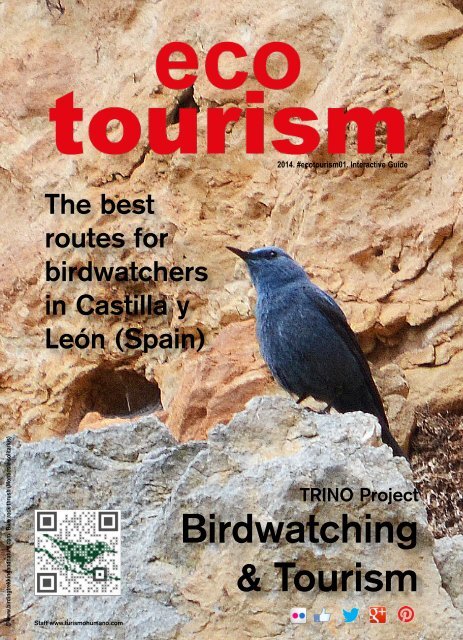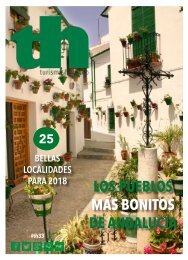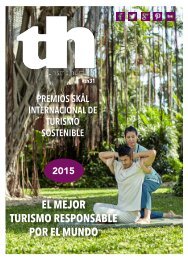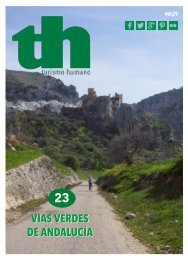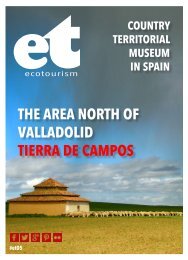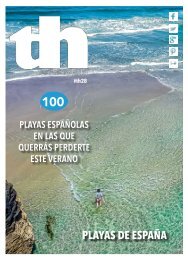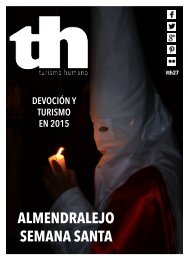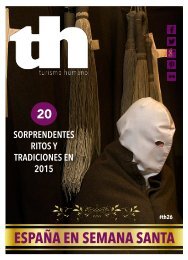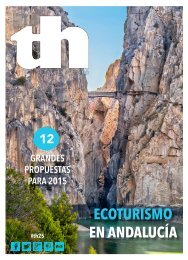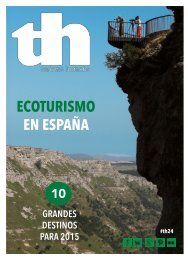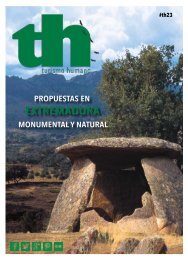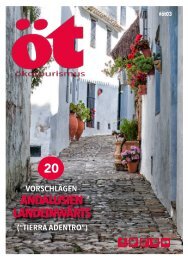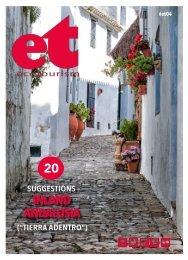#ecotourism01. Birdwatching & Tourism
The best routes for birdwatchers in Castilla y León (Spain)
The best routes for birdwatchers in Castilla y León (Spain)
You also want an ePaper? Increase the reach of your titles
YUMPU automatically turns print PDFs into web optimized ePapers that Google loves.
2014. <strong>#ecotourism01.</strong> Interactive Guide<br />
The best<br />
routes for<br />
birdwatchers<br />
in Castilla y<br />
León (Spain)<br />
© www.birdingtrekkingandnature.com Blue rock thrush (Monticola solitarius)<br />
TRINO Project<br />
<strong>Birdwatching</strong><br />
& <strong>Tourism</strong><br />
Staff www.birdwatchinginspain.com www.turismohumano.com<br />
Eco <strong>Tourism</strong> 1
TRINO<br />
Common crane (Grus grus)<br />
2 Eco <strong>Tourism</strong> www.birdwatchinginspain,com
6<br />
Little bustard (Tetrax tetrax)<br />
The TRINO Project<br />
Rural tourism and birdwatching<br />
The Trino Project (Rural tourism and birdwatching)<br />
is the plan of thirty Local Action Groups,<br />
it is part of the LEADERCAL programme that<br />
comes under the European Agricultural Fund for<br />
Rural Development (EAFRD) in Castilla y León<br />
(Spain). It endeavours to promote bird watching<br />
holidays in Castilla y León with the objective<br />
of ensuring that the rural accommodation on<br />
offer covers the needs of the bird watchers and<br />
respects nature by using sustainable processes<br />
together with the commitment of good environmental<br />
practises.<br />
The plan’s other objectives are to make sure the<br />
region acquires sharper environmental awareness<br />
through education aimed at children and<br />
young people; as well as to increase the understanding<br />
among arable, dairy and stock farmers;<br />
and to train guides.<br />
There are other activities to make certain you<br />
don’t leave the region disappointed, like the<br />
conservation of protected species and routes<br />
that have been tailored to respect wildlife and<br />
their natural habitats, prepared for bikes, horses<br />
and horse-drawn carriages according to the<br />
species you want to see.<br />
There is a wide-variety of bird-friendly habitats<br />
in the vast geographical area of the Castilla y<br />
León region. From the extensive plains of the<br />
interior to the surrounding mountains, diverse<br />
territories are formed that attract birds of different<br />
species. The birds you can find here include<br />
Euro-Siberian birds like the Capercaillie, Mediterranean<br />
birds like the Spanish Imperial eagle<br />
and steppe birds like the Great Bustard that lives<br />
in moor land.<br />
www.birdwatchinginspain.com Eco <strong>Tourism</strong> 3
4 Eco <strong>Tourism</strong><br />
El Bierzo<br />
(Asodebi)<br />
Montañas del Teleno<br />
Zona Oeste de Salamanca<br />
(Adezos)<br />
Montaña Noroccidental<br />
Leonesa<br />
(Cuatro Valles)<br />
Zamora<br />
Valles de Benavente<br />
(Macovall 2000)<br />
Comarca de<br />
Sayago<br />
(Aderisa)<br />
Salamanca<br />
León<br />
Páramo,<br />
Esla y<br />
Órbigo<br />
(Poeda)<br />
Sierra de Béjar y Francia<br />
(Adriss)<br />
Campos-Pan-<br />
Norte Duero<br />
(Adri Palomares)<br />
Nordeste de Salamanca<br />
Comarca de Alba y Guijuelo<br />
(Adrecag)<br />
Montaña de Riaño<br />
Sur de León<br />
(Adescas)<br />
Tierra de Campos<br />
Palentina<br />
Tierra de Campos (Araduey)<br />
de Valladolid<br />
(Adri Valladolid Norte)<br />
Zona Centro<br />
de Valladolid<br />
Valle del Tiétar<br />
Comarca de<br />
La Moraña<br />
(Adrimo)<br />
Ávila<br />
Montaña<br />
Palentina<br />
Palencia<br />
Cerrato Palentin<br />
Valladolid<br />
Honorse-<br />
Tierra de Pin<br />
Comarca Sta. Mª<br />
la Real de Nieva<br />
(Aidescom)<br />
A<br />
Ca<br />
S<br />
(Adec<br />
S<br />
Segov<br />
Sur<br />
MA<br />
(Grupo
Las Merindades<br />
maya<br />
mino de<br />
antiago<br />
o-Camino)<br />
o<br />
Burgos<br />
Comarca del<br />
Arlanza<br />
(Adecoar)<br />
La Bureba<br />
(Adeco-Bureba)<br />
Sierra de la<br />
Demanda<br />
(Agalsa)<br />
Ribera del Duero<br />
Burgalesa<br />
Soria<br />
ares<br />
egovia<br />
Comarca de Almazán<br />
(Adema)<br />
ia<br />
PA INTERACTIVO DE TERRITORIO TRINO<br />
s de Acción Local adheridos al Proyecto Trino)<br />
www.birdwatchinginspain.com Eco <strong>Tourism</strong> 5
Route Madrigal de las Altas Torres<br />
La Moraña (Ávila)<br />
White stork<br />
Red kite<br />
Montagu´s harrier<br />
Hen harrier<br />
Lesser kestrel<br />
Hobby<br />
Merlin<br />
Crane<br />
Little bustard<br />
Great bustard<br />
Birds of interest<br />
Black-bellied sandgrouse<br />
Pin-tailed sandgrouse<br />
Blackwinged stilt<br />
Stone curlew<br />
La Moraña<br />
You can find four different<br />
types of habitat on the plain<br />
in the province of Avila: wheat<br />
and cereal fields, forested<br />
areas, wetlands and rural communities.<br />
The wheat and cereal<br />
fields, an ecosystem with the<br />
greatest environmental importance,<br />
is the habitat of species<br />
of birds that receive the highest<br />
grade of World protection, like<br />
the great bustard and the little<br />
bustard, as well as other birds<br />
just as beautiful and important<br />
like Montagu’s harriers and<br />
stone curlews, sandgrouse and<br />
black-bellied grouse. In this<br />
district in the province of Ávila<br />
there are around 220 species<br />
(65% of those seen in Castilla y<br />
León).<br />
<strong>Birdwatching</strong> routes<br />
• El Oso Wetlands (weekend)<br />
• Lagunas de El Oso<br />
• Madrigal de las Altas Torres<br />
- Rasueros<br />
Tourist services<br />
Landscape<br />
Cereal plains, pine forests, groves,<br />
thicket, wetlands, pasture<br />
El Oso wetlands<br />
6 Eco <strong>Tourism</strong> www.birdwatchinginspain,com
The Tiétar valley (Ávila)<br />
Black stork<br />
White stork<br />
Honey buzzard<br />
Black-shouldered kite<br />
Black kite<br />
Short-toed eagle<br />
Spanish imperial eagle<br />
Booted eagle<br />
Golden eagle<br />
Black vulture Birds of interest<br />
Hobby<br />
Crane<br />
Little tern<br />
Eagle owl<br />
Roller<br />
Lesser spotted woodpecker<br />
Bluethroat<br />
Spanish sparrow<br />
The Tiétar valley<br />
As a whole, the areas of Red<br />
Natura 2000: Sierra de Gredos,<br />
Valle del Tiétar and the Cerros<br />
de Guisando, occupy 81% of<br />
the area of the Tiétar valley<br />
district. In the area around the<br />
Rosarito marsh, there are hides<br />
where you can watch different<br />
birds like anatidae and cranes.<br />
At the confluence with the<br />
Tiétar gorge there is a chance<br />
of seeing black storks, in danger<br />
of extinction. The Hiruelas<br />
valley, the Pico mountain pass<br />
and the Torozo peak are other<br />
options; not forgetting the SPA<br />
(Special Protection Area) at<br />
Castañar de Casillas.<br />
<strong>Birdwatching</strong> routes<br />
• The Surroundings of Rosarito<br />
Reservoir in Candeleda<br />
• Castañar de Casillas<br />
• Tiétar Valley and Sierra de<br />
Gredos Natural Park (ZEPA)<br />
(weekend)<br />
Visit this district<br />
Tourist services<br />
Landscape<br />
Mediterranean forest, groves, thicket,<br />
mountain pasture, wetlands.<br />
The Surroundings of Rosarito Reservoir in Candeleda Castañar de Casillas<br />
www.birdwatchinginspain.com Eco <strong>Tourism</strong> 7
Middle spotted woodpecker (Dendrocopos medius)<br />
La Bureba (Burgos)<br />
Birds of interest<br />
Egyptian vulture<br />
Griffon vulture<br />
Chough<br />
Golden eagle<br />
Bonelli´s eagle<br />
Peregrin<br />
Grey partridge<br />
Honey buzzard<br />
Woodcock<br />
Eagle owl<br />
Alpine chough<br />
La Bureba<br />
The territory that makes up la<br />
Bureba forms part of the transition<br />
zone between the Bay of<br />
Biscay and the Mediterranean,<br />
this favours the existence of a<br />
wide variety of habitats and<br />
consequently, different species<br />
of birds. The recommended<br />
places for bird-watching: the<br />
Obécuri and Bajauri woods,<br />
where most representative<br />
species in this woodland is the<br />
population of middle spotted<br />
woodpeckers, one of the most<br />
important on the Iberian Peninsula;<br />
the Montes Obarenes Nature<br />
Park and the area around<br />
the Ubierna river, as well as the<br />
Rucios gorge and stream.<br />
<strong>Birdwatching</strong> routes<br />
• The Woods of Obécuri &<br />
Bajauri<br />
• El Pan Perdido<br />
• Ubierna between the dehesa<br />
and the gorge<br />
Visit this district<br />
Tourist services<br />
Landscape<br />
Ubierna gorge<br />
Rocky crags, Atlantic forest, Mediterranean<br />
forest, groves, thicket<br />
8 Eco <strong>Tourism</strong> www.birdwatchinginspain,com
Amaya-Pilgrim Way of St. James (Burgos)<br />
Birds of interest<br />
Egyptian vulture<br />
Griffon vulture<br />
Hen harrier<br />
Montagu´s harrier<br />
Golden eagle<br />
Peregrine<br />
Eagle owl<br />
Chough<br />
Alpine chough<br />
Rock thrush<br />
Amaya-Camino de Santiago<br />
(St. James’ Way)<br />
In this district there are two very<br />
different areas: in the North<br />
zone where the landscape is<br />
much more mountainous and<br />
with a wealth of game mainly<br />
in the Ebro and Rudrón gorges.<br />
The area of the Amaya rock,<br />
the surrounding area and the<br />
Humada, Rebolledo de la<br />
Torre, the Tozo and Valdelucio<br />
valleys are examples of landscape<br />
shaped by the action of<br />
numerous rivers which contrasts<br />
with the high and sparse moor.<br />
Both areas have been included<br />
as SPA’s (Special Protection<br />
Area) and SCI’s (Site of<br />
Community Importance).<br />
<strong>Birdwatching</strong> routes<br />
• Gorge of the river Rudrón<br />
• Lagoons of Villasandino<br />
• Cortados of Peña Ulaña<br />
• ZEPA Humada-Peña Amaya<br />
and Rudrón (weekend)<br />
Visit this district<br />
Tourist services<br />
Landscape<br />
Rocky crags, moorland<br />
Cortados of Peña Ulaña<br />
Rudrón River<br />
www.birdwatchinginspain.com Eco <strong>Tourism</strong> 9
Steppe Birds at Villangómez<br />
The Arlanza district (Burgos)<br />
Birds of interest<br />
Egyptian vulture<br />
Griffon vulture<br />
Hen harrier<br />
Golden eagle<br />
Bonelli´s eagle<br />
Peregrine<br />
Eagle owl<br />
Alpine swift<br />
Blue rock thrush<br />
The Arlanza district<br />
The mountains of the Upper<br />
Arlanza called Sabinares del<br />
Arlanza and the banks of the<br />
rivers have been designated<br />
as SPA’s and SCI’s. In the areas<br />
where cereals are grown you<br />
can see birds like the great<br />
bustard, partridge, quail, crow<br />
and shrike, and of course birds<br />
of prey. The riparian forest, as<br />
well as the abundance of small<br />
fish and insects, provide food<br />
for the kingfishers, grey herons,<br />
nightingales and lesser whitethroats.<br />
Egyptian and Griffon<br />
vultures can be found in the<br />
gorges. Birdsong of birds like<br />
the nightingale, lesser whitethroats,<br />
icterine warblers and<br />
golden orioles can be heard by<br />
the riversides.<br />
<strong>Birdwatching</strong> routes<br />
• Steppe Birds at Villangómez<br />
• The River Valley at Lerma<br />
• Mataviejas Gorge<br />
Visit this district<br />
Tourist services<br />
The River Valley at Lerma<br />
Landscape<br />
Rocky crags, moorland,<br />
Mediterranean forest<br />
10 Eco <strong>Tourism</strong> www.birdwatchinginspain,com
The Duero riverside in the province of Burgos<br />
Birds of interest<br />
Egyptian vulture<br />
Griffon vulture<br />
Golden eagle<br />
Peregrine<br />
Eagle owl<br />
Dupont´s lark<br />
Alpine swift<br />
Black wheatear<br />
Blue rock thrush<br />
Chough<br />
Red-backed shrike<br />
The Duero riverside in the<br />
province of Burgos<br />
The Valleys of the Duero and<br />
Esgueva rivers make up a territory<br />
with many similar elements,<br />
the valley landscape is made<br />
up of plains, undulated land,<br />
hills and slopes that are dotted<br />
between irrigated land, cereal<br />
crops, vines and mountains. It<br />
is a predominantly agricultural<br />
area that has been farmed<br />
since ancient times, from the<br />
fertile vales of irrigated land to<br />
the extensive fields of cereal<br />
crops, not forgetting the vines<br />
dotted over the countryside.<br />
An extremely beautiful landscape<br />
that is characteristically<br />
riverside and wooded with a<br />
great bird wealth.<br />
<strong>Birdwatching</strong> routes<br />
• Wetlands of Villaba de Duero<br />
• La Aguilera and its birds<br />
• The reservoir of Tórtoles de<br />
Esgueva<br />
Visit this distict<br />
Tourist services<br />
Landscape<br />
Cereal plains, groves, thicket,<br />
moorland, rocky crags, Mediterranean forest<br />
Reservoir of Tíórtoles de Esgueva<br />
Wetlands of Villaba de Duero<br />
www.birdwatchinginspain.com Eco <strong>Tourism</strong> 11
The Hacinas Lagoons<br />
Sierra de la Demanda (Burgos)<br />
Landscape<br />
Atlantic forest, lagoons and peatland,<br />
glaciers, high mountain pasture, rocky<br />
crags, pine forests, groves, thicket<br />
Sierra de la Demanda<br />
La Sierra de la Demanda has<br />
two SPAs (Sierra de la Demanda<br />
and Sabinares del Arlanza),<br />
both belonging to Mediterranean<br />
bio-geographic regions.<br />
The interesting wetlands of<br />
Atapuerca and Hacinas are<br />
added to these.<br />
Out of the birds found in the<br />
Sierra de la Demanda there<br />
are white storks, Montagu’s<br />
harriers, Egyptian vultures, turtle<br />
dove, Bonelli’s eagles, golden<br />
eagles, Griffon vultures, peregrine<br />
falcons, eagle owls, shorttoed<br />
eagles, booted eagles,<br />
black kites and many others.<br />
The presence of hen harriers,<br />
European honey buzzards and<br />
Iberian grey partridges deserve<br />
a mention because of the special<br />
protection they receive.<br />
<strong>Birdwatching</strong> routes<br />
• Atapuerca Wetland<br />
• The Hacinas Lagoons<br />
• Mataviejas Gorge<br />
Visit this district<br />
Tourist services<br />
Birds of interest<br />
Hen harrier<br />
Grey partridge<br />
Honey buzzard<br />
Golden eagle<br />
Peregrine<br />
Treecreper<br />
Woodcock<br />
Alpine accentor<br />
Rock thrush<br />
Griffon vulture (Gyps fulvus)<br />
12 Eco <strong>Tourism</strong> www.birdwatchinginspain,com
Las Merindades (Burgos)<br />
Birds of interest<br />
Egyptian vulture<br />
Griffon vulture<br />
Hen harrier<br />
Montagu´s harrier<br />
Golden eagle<br />
Bonelli´s eagle<br />
Peregrine<br />
Eagle owl<br />
Alpine swift<br />
Dupont´s lark<br />
Alpine chough<br />
The Wetlands of the Ebro Reservoir<br />
Las Merindades<br />
The region has a total area of<br />
2,717 km 2 . It is comprised of 27<br />
municipalities. Transition zone<br />
between the Atlantic and<br />
Mediterranean, the two large<br />
European bio-geographic<br />
regions, making this district a<br />
true bird paradise because of<br />
its landscape and biological<br />
diversity. With regard to the<br />
birdlife, Las Merindades has<br />
around 175 different species<br />
that can be seen at different<br />
times of the year because birds<br />
nest here, spend the summer or<br />
winter as well as migrate from<br />
the north of Europe in search of<br />
warmer climes.<br />
<strong>Birdwatching</strong> routes<br />
• Ebro Reservoir and Ojo<br />
Guareña Natural Monument<br />
(weekend)<br />
• The Wetlands of the Ebro<br />
Reservoir<br />
• Lakes of Gayangos<br />
Visit this district<br />
Tourist services<br />
Landscape<br />
Rocky crags, groves, thicket,<br />
moorland, Atlantic forest, Mediterranean forest<br />
The Antuzanos Lagoons<br />
www.birdwatchinginspain.com Eco <strong>Tourism</strong> 13
The Sahagún- South of Leon area (León)<br />
Landscape<br />
Cereal plains, wetland<br />
Sahagún–Southeast León<br />
Region<br />
Tierra de Campos, los Oteros<br />
and the foothills give this district<br />
a great landscape diversity<br />
over a relatively small area,<br />
where you can hike, fish, take a<br />
cycle route, canoe, horse ride<br />
and even fly in a light aircraft.<br />
Additionally, the Southeast of<br />
Leon has a network of wetlands<br />
and other fluvial reserves<br />
that are ideal for bird-watching<br />
from hides situated on the main<br />
lakes. You can also see steppeland<br />
birds like the great bustard<br />
in Tierra de Campo. A territory<br />
dotted with small steppe-land<br />
lakes and wetlands.<br />
The area in which Sahagún –<br />
Southeast León Region works<br />
includes 41 municipalities, with<br />
166 localities.<br />
Rebollares del Cea<br />
<strong>Birdwatching</strong> routes<br />
• Valverde - Enrique<br />
• Rebollares del Cea<br />
Visit this district<br />
Tourist services<br />
Montagu´s harrier<br />
Lesser kestrel<br />
Great bustard<br />
Marsh harrier<br />
Hen harrier<br />
Little bustard<br />
Blackbellied sandgrouse<br />
Short-eared owl<br />
Merlin Dotterel<br />
Rook<br />
Great Bittern (Botaurus stellaris)<br />
Birds of interest<br />
14 Eco <strong>Tourism</strong> www.birdwatchinginspain,com
The Bierzo district (León)<br />
Birds of interest<br />
Honey buzzard<br />
Hen harrier<br />
Grey partridge<br />
Rock thrush<br />
The Bierzo district<br />
The Bierzo district is situated in<br />
the northwest of the province<br />
of Leon. The most characteristic<br />
of the terrain is its shape,<br />
like a bowl surrounded by<br />
mountains with peaks of up to<br />
2.000 metres. Good territory for<br />
bird-watching especially by<br />
the Rebolo stream, in the Sierra<br />
de los Ancares or the stunning<br />
landscape of Las Médulas. The<br />
route to the largest wetlands in<br />
the district, the Carucedo lake,<br />
takes you past some impressive<br />
chestnuts groves and you go<br />
through a rich riverside and<br />
lake ecosystem, where you<br />
can see birds typical of these<br />
environments.<br />
<strong>Birdwatching</strong> routes<br />
• Las Médulas and Montes<br />
del Teleno (weekend)<br />
• The Birds of Carucedo<br />
• Peranzanes and its birds<br />
• Arroyo del Rebolo<br />
Visit this district<br />
Tourist services<br />
Capercaille<br />
Golden eagle<br />
Black woodpecker<br />
Woodcock<br />
Atlantic forest, high mountain, pasture<br />
Landscape<br />
The birds of Carucedo Arnado en la ruta del Arroyo del Rebolo<br />
www.birdwatchinginspain.com Eco <strong>Tourism</strong> 15
Four valleys (León)<br />
Capercaille<br />
Grey partridge<br />
Golden eagle<br />
Hen harrier<br />
Honey buzzard<br />
Montagu´s harrier<br />
Black woodpecker<br />
Woodcock<br />
Bluethroat<br />
Treecreper<br />
Alpine accentor<br />
Rock thrush<br />
Four valleys<br />
Situated between the mountains<br />
of the Bay of Biscay and the<br />
moors in the province of Leon,<br />
they provide their districts with<br />
a wealth of nature. On route<br />
you will probably see birds of<br />
prey like the griffon vulture, the<br />
Egyptian vulture, short-toed eagle<br />
and the common buzzard.<br />
In the woods you can see Eurasian<br />
nuthatches, goldcrests,<br />
Eurasian bullfinches, Eurasian<br />
Jays, marsh tits...<br />
Villameca reservoir<br />
Birds of interest<br />
<strong>Birdwatching</strong> routes<br />
• Valporquero de Torío<br />
• Caboalles mixed woods<br />
• Villameca reservoir<br />
• Babia and Valle de San<br />
Emiliano-Natural Area<br />
• Vegacervera Ravines and<br />
Picos de Europa<br />
• Colonia de Cigüeñas de<br />
Santibañez<br />
• Embalse de Selga de Ordás<br />
• Laguna de las Verdes<br />
• Robledales de la Lomba<br />
Visit this district<br />
Tourist services<br />
Landscape<br />
High mountain, rocky crags, Atlantic forest<br />
Caboalles mixed woods<br />
16 Eco <strong>Tourism</strong> www.birdwatchinginspain,com
The Riaño Mountain (León)<br />
Birds of interest<br />
Honey buzzard<br />
Capercaille<br />
Grey partridge<br />
Black woodpecker<br />
Middle Spotted woodpecker<br />
Rock thrush<br />
Chough<br />
Snowfinch<br />
Treecreper<br />
Alpine accentor<br />
Citril finch<br />
The Woods of Robledo de la Guzpeña<br />
The Riaño Mountain<br />
This territory forms part of a<br />
SPA (Special Protected Area),<br />
which allows the conservation<br />
of different species of birds that<br />
you can easily watch: eagles,<br />
woodpeckers, owls or Egyptain<br />
vultures, as well as other<br />
species you can see in the<br />
thickets and rocky areas of the<br />
Picos de Europa Park; you can<br />
also see cormorants, seagulls,<br />
herons and ducks out of the<br />
species that live in the rivers<br />
and marshes.<br />
The territory is also appropriate<br />
for other wild animals like wolves,<br />
bears, ibex or deer.<br />
Landscape<br />
Atlantic forest, rocky crags, high mountain<br />
<strong>Birdwatching</strong> routes<br />
• River Curueño basin around<br />
Ranedo<br />
• The Woods of Robledo de<br />
la Guzpeña<br />
• Vegacervera Ravines and<br />
Picos de Europa (weekend)<br />
Visit this district<br />
Tourist services<br />
River Curueño basin<br />
www.birdwatchinginspain.com Eco <strong>Tourism</strong> 17
The Teleno Mountains (León)<br />
Hen harrier<br />
Peregrine<br />
Rock thrush<br />
Montagu´s harrier<br />
Golden eagle<br />
Short-toed eagle<br />
Booted eagle<br />
Eagle owl<br />
Bluethroat<br />
Alpine swift<br />
Blue rock thrush<br />
Chough<br />
Little bustard<br />
Black-shouldered kite<br />
Stone curlew<br />
The Teleno Mountains<br />
In the area of over 2.100 km² of<br />
this district there is a surprising<br />
natural mosaic with places that<br />
combine profiles and elements,<br />
that are characteristic of the<br />
mountains, with other types of<br />
plains and riversides. An area<br />
of 242.900 square hectares is<br />
protected as a SPA (Special<br />
Protection Area) and another<br />
43.775 square hectares is<br />
protected as a SCI (Site of<br />
Community Importance), it also<br />
has a rich and varied natural<br />
heritage with attractive endemic<br />
flora and fauna. There<br />
are privileged areas for seeing<br />
these and for bird-watching<br />
with an interpretation centre at<br />
Jiménez de Jamuz, part of the<br />
“Valdería- Jamuz” SPA.<br />
Santa Elena de Jamuz<br />
Birds of interest<br />
<strong>Birdwatching</strong> routes<br />
• The slopes of Teleno<br />
• Santa Elena de Jamuz<br />
• Las Médulas and Montes<br />
del Teleno (weekend)<br />
Visit this district<br />
Tourist services<br />
Landscape<br />
Rocky crags, high mountain, pasture,<br />
uncultivated land, agricultural fields<br />
The slopes of Teleno<br />
18 Eco <strong>Tourism</strong> www.birdwatchinginspain,com
Páramo, Órbigo and Esla (León)<br />
Birds of interest<br />
Montagu´s harrier<br />
Little bustard<br />
Black-shouldered kite<br />
Short-toed eagle<br />
Stone curlew<br />
Calandra lark<br />
Short-toed lark<br />
Thekla lark<br />
Tawny pipit<br />
Ortolan bunting<br />
Steppeland birds in La Antigua<br />
Páramo, Órbigo and Esla<br />
Land of deeply rooted traditions<br />
with an area of 8.036<br />
hectares protected by a SPA<br />
(Special Protection Area) and<br />
another 806 by SCI (Site of<br />
Community Importance). It has<br />
the perfect eco-system for the<br />
heaviest flying bird in the world,<br />
the impressive great bustard,<br />
you can see flocks from the<br />
roadside and even though<br />
you can see small lake birds<br />
like little grebes and moorhens,<br />
the most typical group of birds<br />
in the area is the steppe-land<br />
birds: Montagu’s harriers, hen<br />
harriers, lesser kestrels, little bustards,<br />
crested larks and calandra<br />
lark.<br />
Landscape<br />
Cereal plains, wetland<br />
<strong>Birdwatching</strong> routes<br />
• Steppeland birds in La Antigua<br />
• Route through the lowlands<br />
of the river Órbigo<br />
• Valderia Special Bird Protection<br />
Area (ZEPA)<br />
Visit this district<br />
Tourist services<br />
The lowlands of the river Órbigo<br />
www.birdwatchinginspain.com Eco <strong>Tourism</strong> 19
TRINO<br />
The best routes for birdwatching<br />
The proposed routes are an attempt to lure<br />
the general public so that all might enjoy nature<br />
through a different type of tourism such<br />
as ornithology. With this end, some regional<br />
and county trails have been designed in<br />
some of the most representative areas from<br />
an ornithological stand point.<br />
The aim of the TRINO Project is to promote<br />
hiking as a way to get closer to birds and<br />
their habitat, as well as to the cultural and<br />
monumental heritage as a complement to<br />
the development of sustainable tourism in<br />
Castilla y León by using new technologies<br />
and the many associated applications and<br />
programmes.<br />
Provincial routes<br />
These routes are intended to be done on foot or<br />
by bicycle, and they go through some of the most<br />
amazing environments, especially known for their<br />
rich birdlife and exquisite landscapes.<br />
Regional routes<br />
These routes have been designed to be<br />
done by car with some designated stops to<br />
personally discover the ornithological gems<br />
and amazing scenery which these places<br />
possess. There are 15 possible weekend<br />
routes and 5 which take the entire week. In<br />
these, the places of interest are established<br />
as well as the most emblematic birds in each<br />
area, and a specific itinerary is proposed for<br />
each day.<br />
Hiking in Las Merindades (Burgos) © Sol Martín<br />
20 Eco <strong>Tourism</strong> www.birdwatchinginspain,com
Cerrato Palentino (Palencia)<br />
Birds of interest<br />
Red-necked nightjar<br />
Sardinian warbler<br />
Orphean warbler<br />
Azure-winged magpie<br />
Spanish sparrow<br />
Thekla lark<br />
Spectacled warbler<br />
Blackeared wheatear<br />
Pin-tailed sandgrouse<br />
Dupont´s lark<br />
Black-shouldered kite<br />
Goshawk<br />
The hut of La Cabañona. Monte Dueñas<br />
Cerrato Palentino<br />
From the point of view of its<br />
natural and bird wealth, the<br />
Natura 2000 network (areas of<br />
important natural and ecological<br />
value) the Cerrato is made<br />
up of the SPA (Special Protection<br />
Area for birds) of the river<br />
side of the Pisuerga and the<br />
SCIs (Sites of Community Importance)<br />
of the Torozos mountains<br />
and Torquemada-Astudillo<br />
moors within the SCI of the<br />
Cerrato Mountains. Their main<br />
bird value is in the meadows of<br />
cereal crops and the wetlands.<br />
Landscape<br />
Moorland, Mediterranean forest,<br />
agricultural fields<br />
<strong>Birdwatching</strong> routes<br />
• Baltanás - Antigüedad<br />
• Monte de Dueñas<br />
• The Portuguese Oak Wood<br />
Of Hérmedes<br />
• Villaviudas<br />
• Arroyo del Maderón - Monte<br />
Girón<br />
• Vertavillo - Valle de Arranca<br />
• Villamediana - Monte de<br />
Torquemada<br />
Visit this district<br />
Tourist services<br />
Quejigal de Hérmedes<br />
www.birdwatchinginspain.com Eco <strong>Tourism</strong> 21
Palentina Mountain (Palencia)<br />
Birds of interest<br />
Egyptian vulture<br />
Grey partridge<br />
Middle Spotted woodpecker<br />
Honey buzzard<br />
Short-toed eagle<br />
Alpine swift<br />
Alpine accentor<br />
Snowfinch<br />
Treecreper<br />
Palentina Mountain<br />
The extensive fields of cereal<br />
crops are dotted with woods,<br />
mountains and gorges. On the<br />
flat areas you can detect the<br />
presence of stonechats, white<br />
storks, skylarks, serins, buntings<br />
and hoopoes in summer, as<br />
well as other bird species. In<br />
the whole territory it is easy to<br />
see all types of birds among<br />
the green cultivated land, thick<br />
oak groves and the riverside<br />
vegetation along the streams.<br />
From San Martín de Perapertú to Mudá<br />
River Pisuerga in Villaescusa de las Torres<br />
<strong>Birdwatching</strong> routes<br />
• Between Nestar and Cordovilla<br />
de Aguilar<br />
• From San Martín de Perapertú<br />
to Mudá<br />
• River Pisuerga in Villaescusa<br />
de las Torres<br />
• Parque Natural Fuentes Carrionas<br />
and Fuente Cobre<br />
(weekend)<br />
Visit this district<br />
Tourist services<br />
Landscape<br />
High mountain, rocky crags, Atlantic forest,<br />
heathland, pasture<br />
22 Eco <strong>Tourism</strong> www.birdwatchinginspain,com
Tierra de Campos Palentina (Palencia)<br />
Birds of interest<br />
Purple heron<br />
Marsh harrier<br />
Montagu´s harrier<br />
Lesser kestrel<br />
Great bustard<br />
Spoonbill<br />
Greylag goose<br />
Bittern<br />
Little bittern<br />
Bearded tit<br />
Savi´s warbler<br />
Reed bunting<br />
Canal de Castilla<br />
Tierra de Campos<br />
A privileged place for bird<br />
watching because in its agricultural<br />
land, riversides and<br />
wetlands you can find steppeland<br />
birds and large numbers<br />
of water birds in the La Nava,<br />
Boada and Pedraza lakes.<br />
The district has three Natura<br />
2000 areas with the SPA classification,<br />
designated by their<br />
important steppe-land bird<br />
populations like great bustards,<br />
little bustards, Montagu’s harriers<br />
and kestrels.<br />
Landscape<br />
Cereal plains, wetland<br />
<strong>Birdwatching</strong> routes<br />
• Boada Wetlands<br />
• The Birds of the Canal de<br />
Castilla<br />
• Riverbank and Mediterranean<br />
Woods at Población de Arroyo<br />
• River Carrión Between Canals<br />
• Camino de Santiago<br />
Visit this district<br />
Tourist services<br />
Carrión river<br />
www.birdwatchinginspain.com Eco <strong>Tourism</strong> 23
West of Salamanca (Salamanca)<br />
Landscape<br />
Sparse wood pasture, rocky crags,<br />
Mediterranean forest, groves, thicket<br />
West of Salamanca<br />
The land to the west of the province<br />
of Salamanca stretches<br />
as far as the frontier with Portugal<br />
and includes the districts of<br />
Tierra de Vitigudino, Las Arribes<br />
del Duero, el Abadengo, la<br />
Ramajería and Tierra de Ledesma.<br />
The people have kept a<br />
traditional lifestyle that respects<br />
the environment and helps the<br />
conservation of the area. Part<br />
of the Arribes del Duero Nature<br />
Park is within this region, one of<br />
the largest protected areas in<br />
Europe, it has been designated<br />
as a SPA (Special Protected<br />
Area) as well as a SCI (Site of<br />
Community Importance).<br />
Route Gema Flour Factory<br />
<strong>Birdwatching</strong> routes<br />
• Arribes del Duero<br />
(weekend)<br />
• Gema - Flour Factory<br />
• Ledesma - Puente Mocho<br />
• Pereña de la Ribera - Mirador<br />
de la Ermita<br />
Visit this district<br />
Tourist services<br />
Black stork<br />
Egyptian vulture<br />
Griffon vulture<br />
Golden eagle<br />
Bonelli´s eagle<br />
Birds of interest<br />
Red kite<br />
Peregrine<br />
Eagle owl<br />
Dupont´s lark<br />
Mirador de la Ermita<br />
24 Eco <strong>Tourism</strong> www.birdwatchinginspain,com
The Alba and Guijuelo region (Salamanca)<br />
Birds of interest<br />
Black stork<br />
Little bittern<br />
White stork<br />
Honey buzzard<br />
Montagu´s harrier<br />
Red kite<br />
Blackshouldered kite<br />
Black vulture<br />
Crane<br />
Ribera del río Tormes<br />
Campo Charro, Alba de<br />
Tormes and Guijuelo<br />
This is a region that comprises<br />
67 municipalities from three<br />
different districts; the Campo<br />
Charro district has a great<br />
nature and landscape value<br />
because it forms part of the<br />
Charra oak tree pastures; the<br />
Alba de Tormes district which<br />
includes parts of the SCI (Site of<br />
Community Importance) of the<br />
riverside of the basin of the river<br />
Tormes and a large part of the<br />
SPA (Special Protected Area)<br />
of Campos de Alba; the Santa<br />
Teresa reservoir is in the Guijuelo<br />
district with a wealth of nature<br />
and birdlife. These districts<br />
have a population of 30.968<br />
and an area of 14.11 km².<br />
Landscape<br />
Sparse wood pasture, Mediterranean<br />
forest, groves, thicket, rocky crags<br />
<strong>Birdwatching</strong> routes<br />
• Las Batuecas Natural Park<br />
(weekend)<br />
• Ribera del río Tormes<br />
• Dehesa Charra<br />
• Santa Teresa Reservoir<br />
Visit this district<br />
Tourist Services<br />
Santa Teresa Reservoir<br />
www.birdwatchinginspain.com Eco <strong>Tourism</strong> 25
Sierra de Béjar and Francia (Salamanca)<br />
Sierra de Béjar and Francia<br />
There are several Special Protection<br />
Areas for birds (SPAs) in<br />
these mountains which strive to<br />
protect the birds through the<br />
conservation of their habitats.<br />
They are Las Batuecas-Sierra<br />
de Francia, Candelario, Las<br />
Quilamas and the river Alagón<br />
providing this area with an attractive<br />
complementary offer:<br />
its birdlife, as a result visitors can<br />
enjoy the beautiful landscape,<br />
the brilliant cultural heritage,<br />
the delicious cuisine as well as<br />
spending a few exciting days<br />
bird-watching, discovering the<br />
species that fly over these mountains.<br />
Route from Cantagallo to the river Forests of Sierra de Béjar y Francia<br />
Landscape<br />
Rocky crags, pine forests, groves,<br />
thicket, heathland<br />
Birds of interest<br />
Black stork<br />
Black vulture<br />
Honey buzzard<br />
Egyptian vulture<br />
Griffon vulture<br />
Golden eagle<br />
Peregrine<br />
<strong>Birdwatching</strong> routes<br />
• Las Batuecas Natural Park<br />
(weekend)<br />
• Route from Cantagallo to<br />
the river<br />
• La Alberca - Herguijuela<br />
Visit this district<br />
Tourist services<br />
26 Eco <strong>Tourism</strong> www.birdwatchinginspain,com
Birds of interest<br />
North-East of Salamanca (Salamanca)<br />
Montagu´s harrier<br />
Great bustard<br />
Black-bellied sangrouse<br />
Pin-tailed sandgrouse<br />
Little bustard<br />
Great crested grebe<br />
Los Arapiloes, sitio histórico donde se libró la batalla de Arapiles (1812)<br />
North-East of Salamanca<br />
The birds from the North-East<br />
of Salamanca are the most<br />
diverse group from among the<br />
vertebrates, with 250 recorded<br />
species. The steppe birdlife<br />
and waterfowl are well represented<br />
in the North-East. The<br />
Riolobos dam has attracted<br />
species that were previously<br />
unknown in this district like the<br />
white-headed duck and the<br />
common shelduck. The zone<br />
has several protected areas<br />
integrated in the Red Natura<br />
2000 network, dependant on<br />
the European Union. Some of<br />
the places have been recognised<br />
as Listed Wetlands.<br />
Landscape<br />
Cereal plains, sparse wood pasture,<br />
groves, thicket, wetland<br />
<strong>Birdwatching</strong> routes<br />
• The fertile plain of the river<br />
Tormes<br />
• Cork Oak wood around<br />
Zamayón - Valdelosa<br />
• Diversion dam of the river<br />
Lobos<br />
• El Oso Wetlands (weekend)<br />
Visit this district<br />
Tourist services<br />
Alcornocal de Zamayón<br />
www.birdwatchinginspain.com Eco <strong>Tourism</strong> 27
Valey of the Voltoya From Melque to Laguna Rodrigo<br />
Santa Maríaª la Real de Nieva (Segovia)<br />
Birds of interest<br />
Black stork<br />
Spanish imperial<br />
eagle<br />
Booted eagle<br />
Landscape<br />
Golden eagle<br />
Red kite<br />
Black vulture<br />
Peregrine<br />
Pine forest and holm oak woods,<br />
wetland, pasture, groves, thicket<br />
The Santa María la Real<br />
de Nieva district<br />
The district has numerous<br />
species of birds in different<br />
habitats. On lakes like the<br />
Laguna Rodrigo you can see<br />
water birds: black-winged<br />
stilts, mallards, grey herons,<br />
Eurasian teals, Northern shovelers.<br />
In the pine groves near<br />
the rivers the diversity of birds<br />
combines woodland species<br />
and riverside birds: European<br />
green woodpeckers, Eurasian<br />
nuthatches, shrikes, blackbirds,<br />
European bee-eaters and treecreepers.<br />
In the areas of cereal<br />
crops there is an abundance of<br />
wood larks, goldfinches, wheatears,<br />
stonechats.<br />
<strong>Birdwatching</strong> routes<br />
• Cantalejo Wetlands<br />
• Valley of the Voltoya<br />
• From Melque to Laguna<br />
Rodrigo<br />
• Valley of Arroyo Tormejón<br />
Visit this district<br />
Tourist services<br />
28 Eco <strong>Tourism</strong> www.birdwatchinginspain,com
Tierra de Pinares (Segovia)<br />
Birds of interest<br />
Black stork<br />
White stork<br />
Spanish imperial eagle<br />
Black kite<br />
Little bittern<br />
Marsh harrier<br />
Blackshouldered kite<br />
Short-toed eagle<br />
Roller<br />
El Espadañal lake<br />
Tierra de Pinares<br />
The wealth of birdlife is especially<br />
interesting in several<br />
areas that have been designated<br />
as SPAs (Special Protection<br />
Areas) and SCIs (Sites of Community<br />
Importance) within the<br />
Red Natura 2000 network, with<br />
special reference to the Cantalejo<br />
lakes. A large part of the<br />
area is marked as an Important<br />
Area for the black stork. These<br />
protected areas together<br />
with others, are very interesting<br />
because of their birdlife, this<br />
is the case of the limestone<br />
moorland and northern gorges<br />
of the river Duratón, making<br />
the Tierra de Pinares district in<br />
the province of Segovia a birdwatching<br />
destination because<br />
of the variety of its eco-systems.<br />
Landscape<br />
Pine forest, wetland, pasture,<br />
groves, thicket<br />
<strong>Birdwatching</strong> routes<br />
• El Espadañal Lake<br />
• Las Madres of river Botija<br />
• Cantalejo Wetlands<br />
Visit this district<br />
Tourist services<br />
Las Madres of river Botija<br />
www.birdwatchinginspain.com Eco <strong>Tourism</strong> 29
South Segovia (Segovia)<br />
Chough<br />
Egyptian vulture<br />
Griffon vulture<br />
Red kite<br />
Short toed eagle<br />
Black stork<br />
Honey buzzard<br />
Spanish imperial eagle<br />
Booted eagle<br />
Golden eagle<br />
Black vulture<br />
Peregrine<br />
Goshawk<br />
Alpine accentor<br />
Bluethroat<br />
Rock thrush<br />
South Segovia<br />
This district comprises 51 municipalities,<br />
mostly situated on<br />
the north slopes of the Sierra<br />
de Guadarrama that give the<br />
district a eminently mountain<br />
character. It has a total area of<br />
1.594 km2, mainly dominated<br />
by the Sierra de Guadarrama.<br />
Over 60% of the territory is<br />
included within the Red Natura<br />
2000 network. The quality of the<br />
fauna in the three SPAs (Special<br />
Protection Areas) is similar<br />
because in fact we are dealing<br />
with three different areas of<br />
the Sierra del Guadarrama. This<br />
territory is within the recovery<br />
zone for the black stork and<br />
the Spanish imperial eagle,<br />
both listed species in danger of<br />
extinction.<br />
Risca de Valdeprados The Streams of Caballar<br />
Birds of interest<br />
Landscape<br />
<strong>Birdwatching</strong> routes<br />
• Risca de Valdeprados<br />
• River Santa Águeda<br />
• The Streams of Caballar<br />
Visit this district<br />
Tourist services<br />
Pasture, high mountain, rocky crags, pine forest<br />
30 Eco <strong>Tourism</strong> www.birdwatchinginspain,com
TRINO<br />
Links<br />
Accommodation<br />
search box<br />
Action <strong>Tourism</strong><br />
Companies<br />
Geoportal<br />
Bird Interpretation<br />
Centre<br />
Augmented Reality<br />
navigation<br />
Provincial routes<br />
Weekend and all<br />
week routes<br />
Search for birds in<br />
English<br />
Ecosystems in<br />
Castilla y León<br />
(Spain)<br />
Common buzzard (Buteo buteo)<br />
www.birdwatchinginspain.com Eco <strong>Tourism</strong> 31
TRINO<br />
Routes with Augmented Reality<br />
navigation on your mobile<br />
Augmented Reality<br />
gives additional<br />
information to an<br />
image taken in<br />
real-time. So the<br />
consumer can<br />
see overlaid information<br />
on the live<br />
image marked with<br />
points of information<br />
that is of interest<br />
to the client.<br />
Layar is used to visualise<br />
this augmented<br />
reality application.<br />
This application<br />
combines the use<br />
of GPS, a digital<br />
compass, a camera<br />
and a permanent<br />
Internet connection.<br />
To be able to use<br />
this application you<br />
need an Android<br />
phone or an iphone<br />
with GPS navigation.<br />
Once you have<br />
downloaded the<br />
Layar application<br />
and the TRINO<br />
overlaid information,<br />
you can see<br />
the most relevant<br />
points of interest on<br />
each of the birdwatching<br />
routes, at<br />
the same time that<br />
you are following the<br />
route on Google Maps.<br />
You can get information<br />
of the different habitats<br />
of the birds in situ, as<br />
well as information<br />
on interesting<br />
monuments.<br />
Black-winged stilt (Himantopus himantopu)<br />
32 Eco <strong>Tourism</strong> www.birdwatchinginspain,com
South-East of Soria (Soria)<br />
Landscape<br />
Agricultural land for cereals,<br />
moorland rocky crags<br />
South-East of Soria<br />
The SPAs (Special Protection<br />
Areas) of Monteagudo de las<br />
Vicarías, Altos de Barahona<br />
and the Layna moors and the<br />
SCIs (Sites of Community Importance)<br />
los Altos de Barahona,<br />
Layna moors, Sabinares del<br />
Jalón, Quejigares de Gómara -<br />
Nágima, Riverside of the Duero<br />
and its tributaries are outstanding<br />
within the Red Natura<br />
2000 network. There is also a<br />
long list of lakes and lagoons in<br />
the Castilla y León region that<br />
are Listed Wetlands of Special<br />
Interest, aimed at favouring<br />
their protection, out of which<br />
the Monteagudo de las Vicarías<br />
reservoir and the Judes<br />
lake are worth a mention.<br />
<strong>Birdwatching</strong> routes<br />
• Ravines at Escalote River and<br />
Monteagudo Reservoir<br />
• Somaen – Avenales<br />
• Barranco de Algondrón<br />
• Bordecorex – Fuentegelmes<br />
Visit this district<br />
Tourist services<br />
Birds of interest<br />
Little bustard<br />
Golden eagle<br />
Black-bellied sandgrouse<br />
Egyptian vulture<br />
Griffon vulture<br />
Dupont´s lark<br />
Montagu´s harrier<br />
Peregrine<br />
Blacknecked grebe<br />
Stone curlew<br />
Bordecorex - Fuentegelme Dupont's Lark (Chersophilus duponti)<br />
www.birdwatchinginspain.com Eco <strong>Tourism</strong> 33
Tierra de Campos (Valladolid)<br />
Birds of interest<br />
Tierra de Campos in the<br />
province of Valladolid<br />
The great bustard is the king<br />
of steppe birds in the fields of<br />
cereal crops, at 0.9 metres tall,<br />
1 metre long, weighing over 18<br />
kilos and with a wingspan of 2<br />
metres it is the heaviest flying<br />
bird in the world. Out of many<br />
other birds the little bustard is<br />
also worth a mention. The lesser<br />
kestrel has its habitual residence<br />
here from the beginning of<br />
spring the same as the red kite.<br />
There are also interesting birds<br />
of prey like the marsh harrier<br />
and even the black-winged<br />
kite.<br />
Tierra de Campos Great bustard (Otis tarda)<br />
Montagu´s harrier<br />
Lesser kestrel<br />
Great bustard<br />
Pin-tailed sandgrouse<br />
Black-bellied sandgrouse<br />
Landscape<br />
Little bustard<br />
Marsh harrier<br />
Red kite<br />
Black-shouldered kite<br />
Short-eared owl<br />
Cereal plains, groves, thicket, wetland<br />
<strong>Birdwatching</strong> routes<br />
• Boada Wetlands<br />
(weekend)<br />
• Melgar de Arriba<br />
• Cuenca de Campos-<br />
Villabaruz de Campos<br />
• La Unión de Campos -<br />
Valdunquillo<br />
Visit this district<br />
Tourist services<br />
34 Eco <strong>Tourism</strong> www.birdwatchinginspain,com
Central zone of the province of Valladolid<br />
Birds of interest<br />
Purple heron<br />
Marsh harrier<br />
Booted eagle<br />
Cormorant<br />
Grey heron<br />
Night heron<br />
Black kite<br />
Great crested grebe<br />
Great reed warbler<br />
The Upland Meadows of Peñaflor de Hornija and Wamba<br />
Central zone of the<br />
province of Valladolid<br />
The nature area of the Castronuño-Vega<br />
del Duero riverside,<br />
and the banks of the Duero<br />
and Pisuerga rivers, are important<br />
ecosystems for birdlife<br />
within the area of action.<br />
Owls and Northern wheatears<br />
perch on the cairns while the<br />
shy quail sings in the wheat<br />
fields. In years when there is<br />
rainfall, migratory species like<br />
shorebirds and anatidae come<br />
to rest here in las Navas (waders<br />
like calidrids, tringas, crab<br />
plovers, anatidaes, etc.) and<br />
among the birds that nest here<br />
are the black-headed gull and<br />
black-winged stilt.<br />
Landscape<br />
Cereal plains, groves, thicket, wetland,<br />
pine forest, Mediterranean forest<br />
<strong>Birdwatching</strong> routes<br />
• Riberas de Castronuño Natural<br />
Park (weekend)<br />
• The Upland Meadows of Peñaflor<br />
de Hornija and Wamba<br />
• Hornija Valley<br />
• Valdegalindo Area<br />
Visit this district<br />
Tourist services<br />
Hornija Valley<br />
www.birdwatchinginspain.com Eco <strong>Tourism</strong> 35
El Duero from Abelón Fariza to the Mirador de Las Barrancas<br />
Sayago District (Zamora)<br />
Black stork<br />
Egyptian vulture<br />
Griffon vulture<br />
Golden eagle<br />
Bonelli´s eagle<br />
Red kite<br />
Peregrine<br />
Eagle owl<br />
Dupont´s lark<br />
Birds of interest<br />
Landscape<br />
Sparse wood pasture, rocky crags,<br />
Mediterranean forest, groves, thicket<br />
Sayago District<br />
Sayago is a very attractive<br />
and rugged area because of<br />
the environmental quality and<br />
the diversity of the landscape<br />
and ecosystems in this territory,<br />
it conserves one of the most<br />
characteristic biological communities<br />
of the Mediterranean<br />
region and many of the most<br />
emblematic species like the<br />
black stork, Bonelli’s eagle and<br />
the Griffon vulture come here.<br />
On the routes to Abelón or to<br />
the Mirador de las Barrancas<br />
you can enjoy spectacular<br />
scenery with a backdrop of<br />
black storks, Egyptian eagles,<br />
Griffon vultures and golden<br />
eagles in flight.<br />
<strong>Birdwatching</strong> routes<br />
• Arribes del Duero<br />
(weekend)<br />
• El Duero from Abelón<br />
• Fariza to the Mirador de Las<br />
Barrancas<br />
Visit this district<br />
Tourist services<br />
36 Eco <strong>Tourism</strong> www.birdwatchinginspain,com
Tierra de Campos-Pan-Norte Duero (Zamora)<br />
Birds of interest<br />
Tierra de Campos-Pan-<br />
Norte Duero<br />
This flat terrain, together with<br />
the poor permeability of the<br />
land, has led to the formation<br />
of lakes like the Lagunas de Villafáfila,<br />
a Nature Reserve and<br />
winter haven for water birds<br />
from the North of Europe.<br />
The Reserve also attracts a large<br />
population of steppe birds,<br />
out of which it is worth mentioning<br />
the great bustard (Otis<br />
tarda) with around 1000 birds<br />
in the month of August on the<br />
post-breeding census and with<br />
numbers reaching 2.500 birds<br />
in the mating season. There are<br />
four SPAs (Special Protection<br />
Areas) in this district.<br />
<strong>Birdwatching</strong> routes<br />
• Ricobayo Reservoir<br />
• Moreruela<br />
• River Sequillo<br />
Visit this district<br />
Tourist services<br />
Marsh harrier<br />
Montagu´s harrier<br />
Lesser kestrel<br />
Great bustard<br />
Greylag goose<br />
Crane<br />
Landscape<br />
Cereal plains, wetland, pasture<br />
Little bustard<br />
Black-winged Stilt<br />
Avocet<br />
Gullbilled tern<br />
Short-eared owl<br />
Santa María de Moreruela River Sequillo<br />
www.birdwatchinginspain.com Eco <strong>Tourism</strong> 37
Benavente Valleys (Zamora)<br />
Birds of interest<br />
Marsh harrier<br />
Montagu´s harrier<br />
Grey heron<br />
Booted eagle<br />
Cormorant<br />
Black kite<br />
Dipper<br />
Nightjar<br />
Short-toed eagle<br />
Peregrine<br />
Benavente Valleys<br />
The Valles de Benavente district<br />
is a crossing for some of the<br />
main rivers in the north-west<br />
basin of the river Duero. You<br />
can find over 40 species of<br />
birds linked to these aquatic<br />
habitats, some representative<br />
species include kingfishers,<br />
sand martins, bee-eaters, Eurasian<br />
tree sparrows, wagtails,<br />
pipits, etc.<br />
On route between the Congosta<br />
and Ayoo reservoirs you can<br />
see water birds like the great<br />
crested grebe and the Eurasian<br />
coot that have found their<br />
ideal habitat here.<br />
Embalse de Congosta Milles de Polvorosa<br />
Landscape<br />
<strong>Birdwatching</strong> routes<br />
• Reservoirs of Congosta and<br />
Ayoo de Vidriales<br />
• Milles de Polvorosa<br />
Visit this district<br />
Tourist services<br />
Cereal plains, wetland, pasture, pine forests, Mediterranean forest<br />
38 Eco <strong>Tourism</strong> www.birdwatchinginspain,com
Local Action Groups of the TRINO project<br />
TRINO<br />
www.birdwatchinginspain.com Eco <strong>Tourism</strong> 39
www.birdwatchinginspain.com


